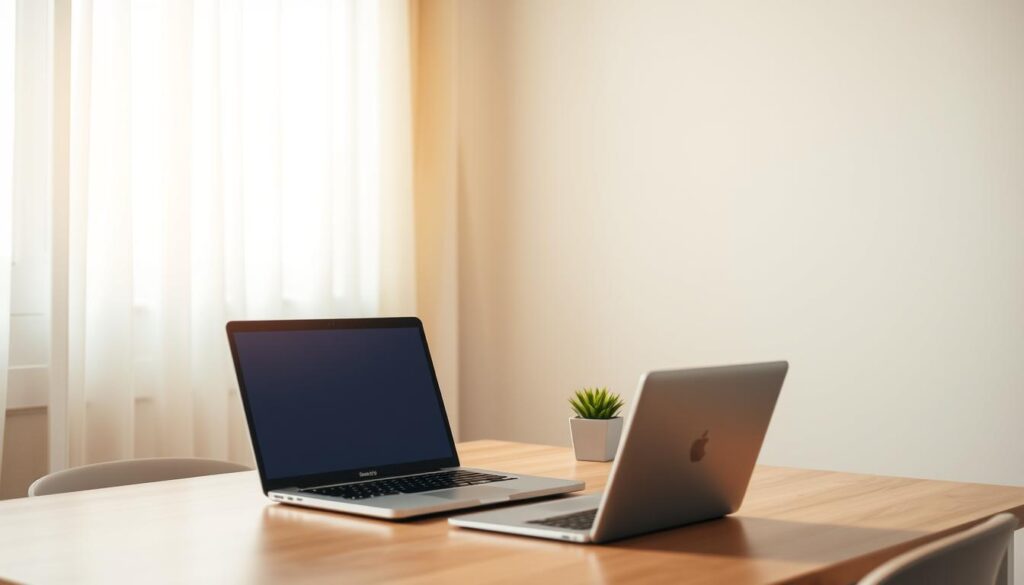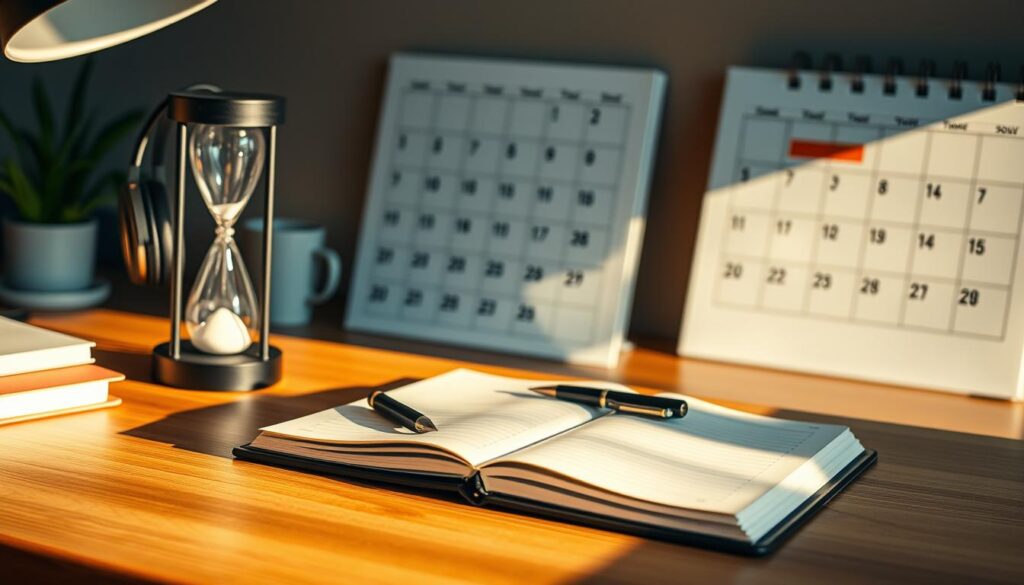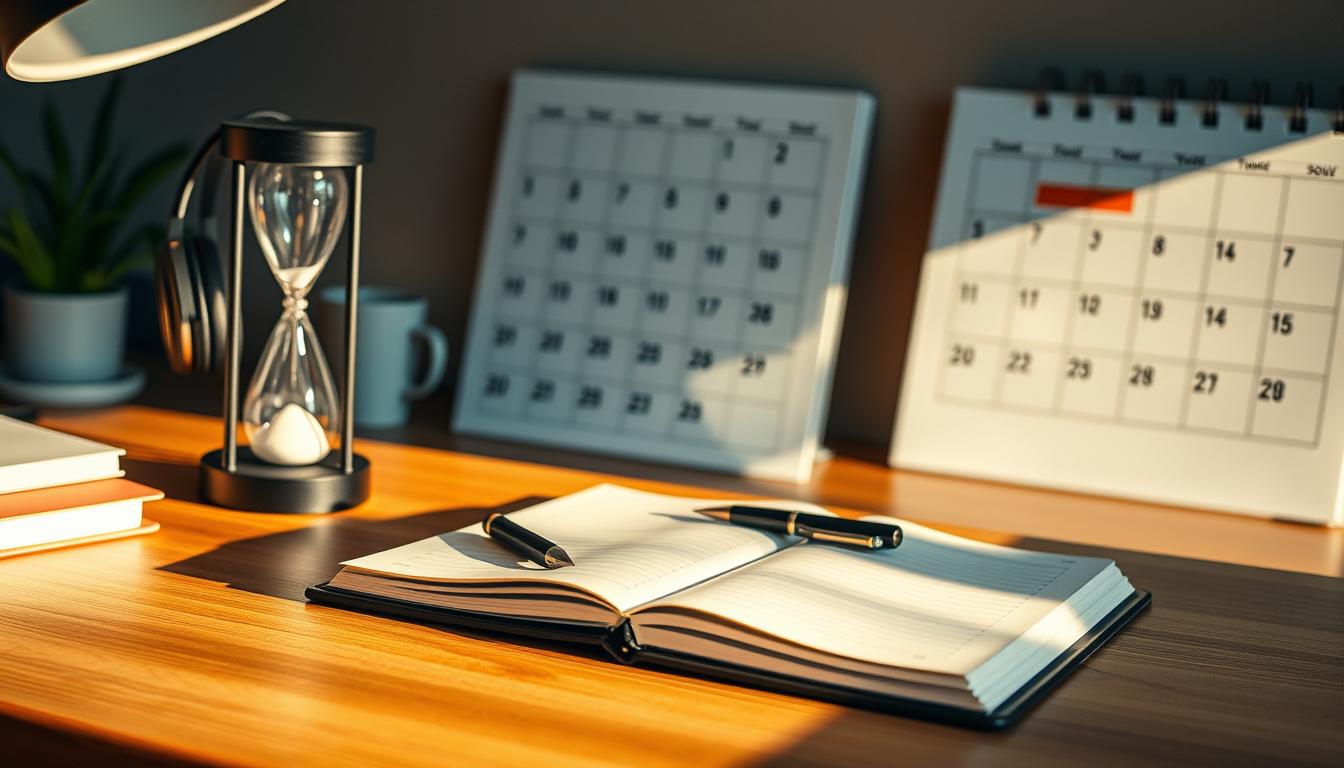In today’s digital world, it’s key to avoid digital distractions to boost productivity and manage time better. By cutting down on digital distractions, people can focus better and reach their goals faster. This article will share easy tips to avoid digital distractions and boost digital wellness, vital for staying productive today.

With digital devices always at our fingertips, staying focused can be tough. Yet, simple strategies can help reduce digital distractions and enhance digital wellness. This leads to more productivity and a healthier work-life balance, key for success.
Key Takeaways
- Avoiding digital distractions is essential for increasing productivity and better time management.
- Minimizing digital distractions can improve focus and help individuals achieve their goals more efficiently.
- Digital wellness is critical for productivity tips in the modern world.
- Simple strategies can be implemented to reduce digital distractions and improve overall digital wellness.
- Increased productivity and a better work-life balance can be achieved by avoiding digital distractions.
- Improving digital wellness can lead to increased success in personal and professional life.
Understanding the Impact of Digital Distractions in Modern Life
In today’s world, minimizing distractions is key for staying productive and feeling good. Things like social media and email alerts can really mess with our day. It’s important to know how these distractions work and where they come from.
Some common sources of digital disruption include:
- Social media notifications
- Email notifications
- Text messages
- Online advertisements
These distractions can really cut down on how much we get done. By using focus strategies like turning off alerts or blocking websites, we can fight these distractions. This helps us stay focused and get more done.
Also, being always connected can cost us a lot. It affects our work, our minds, and our bodies. By knowing the dangers of digital distractions and trying to minimize distractions, we can live healthier and more productive lives.
Signs You’re Struggling with Digital Overload
Do you have trouble focusing because of all the digital alerts? This might mean you’re dealing with digital overload. It’s a big problem in our world today. You might find it hard to focus, work less efficiently, and feel swamped by too much info.
Common signs of distraction include often checking social media or email. You might feel the urge to stay glued to your devices all the time. Also, you could struggle to finish tasks because of digital interruptions. If you see yourself in these behaviors, it’s time to rethink how you use technology.
- Do you feel anxious when you’re unable to check your devices?
- Are you spending more time on digital devices than intended?
- Are you experiencing decreased productivity due to digital distractions?
If you said yes to any of these, you might be facing digital overload. Spotting these signs is the first step to making a change. It helps you focus on what really matters.
The Psychology of Digital Distractions and Focus
Understanding distractions is key to better focus. Notifications, emails, and social media updates activate our brain’s reward system. This makes it hard to resist checking our devices. Mental resilience helps us stay focused and avoid distractions.
Several factors affect our focus:
- Environmental factors, such as noise levels and clutter
- Internal factors, such as motivation and self-control
- Technological factors, such as the design of devices and apps
Knowing these factors helps us improve our mental resilience. This way, we can stay focused despite digital distractions.
Building mental resilience takes time and practice. By using focus strategies like mindfulness, we can strengthen our minds. This helps us stay focused and reach our goals.
Essential Tools for Avoiding Digital Distractions
It’s hard to stay focused with so many digital distractions around. Luckily, there are tools for focus that can help. Website blockers limit access to distracting sites during certain times. Productivity apps also help, with features like tracking time, setting goals, and sending reminders.
Apps like Freedom, SelfControl, and StayFocusd are popular for their ability to block sites and set time limits. They can even schedule focus sessions. Using these tools for focus daily can help you stay on track and reach your goals faster. Website blockers also help by limiting social media and email checks.
Here are some key features to look for in tools for focus:
- Website blocking and filtering
- Time tracking and scheduling
- Goal setting and reminders
- Customization options for individual needs
Using productivity apps and website blockers can make your work environment better. They help whether you’re working on a project, studying, or just trying to stay focused. These tools for focus can help you meet your goals and cut down on digital distractions.
Creating a Distraction-Free Digital Workspace
To have a distraction-free workspace, we need to look at both our digital and physical spaces. A tidy digital space helps a lot. This means organizing files and folders well and using tools to keep things clean.
It’s also key to set up our devices to help us focus. This includes using website blockers, filters for notifications, and adjusting display settings. By doing this, we can cut down on distractions and stay on task.
Improving our physical workspace is another way to reduce distractions. This can be done by using noise-cancelling headphones, placing computers right, and making our workspace comfy and ergonomic. By combining these digital and physical steps, we can make a workspace that boosts productivity and cuts down on digital distractions.
Some important ways to make a distraction-free digital workspace include:
- Customizing device settings to minimize distractions
- Implementing a digital organization system to reduce clutter
- Creating a physical workspace that promotes focus and comfort
By using these strategies, we can make a workspace that supports our productivity and well-being. It helps us stay focused in today’s digital world.
Time-Blocking Techniques for Enhanced Focus
To boost productivity and cut down on distractions, try time-blocking. This method involves setting aside fixed times for each task. It helps you focus on one thing at a time, avoiding the stress of switching tasks too often.
Effective productivity scheduling is key to time-blocking success. First, list your top tasks and assign specific times for them. Use a calendar or planner to mark these times, keeping distractions away. This way, you can work more efficiently and effectively.

Time-blocking offers many benefits, like better focus and quality work. It also helps you avoid putting things off and stay on track with your goals. Remember to include breaks and self-care activities, like exercise or meditation, to keep your well-being in check.
When using time-blocking, being flexible is important. Don’t get too caught up if your schedule changes. Just adjust it as needed and keep moving forward. With regular use, time-blocking can be a powerful tool for achieving your goals and balancing work and life.
Developing Healthy Digital Boundaries
It’s important to have a balance between our online and offline lives. Setting clear digital boundaries helps us avoid digital overload. This means setting rules for communication, creating device-free areas, and having digital sunset times.
Setting communication expectations is key for healthy digital relationships. We can decide when to check emails or social media. This helps us avoid feeling always connected and keeps us focused.
Creating device-free zones is another good idea. Make some places, like the dinner table, free from devices. This way, we can relax and talk with others without digital distractions.
- Set clear communication expectations with others
- Create device-free zones in the home or office
- Establish digital sunset rules to reduce screen time before bed
Healthy digital boundaries improve our relationships and productivity. They help us manage our digital lives better. By setting boundaries and making device-free areas, we keep a healthy balance between our online and offline worlds.
Mindfulness Practices for Digital Wellness
Embracing mindfulness practices is key for digital wellness in today’s tech world. Simple techniques can reduce stress, boost focus, and improve well-being. Meditation for focus is one such method, calming the mind and boosting productivity.
Being present in the moment is a core part of mindfulness practices. This can be done through deep breathing, yoga, or just taking a few minutes each day. It helps us handle digital info better and keeps our online and offline lives balanced.

To start with mindfulness practices and boost your digital wellness, try these tips:
- Start small: Begin with short meditation or deep breathing exercises. Gradually increase time as you get more comfortable.
- Be consistent: Make mindfulness practices a daily part of your routine, like right after waking up or before bed.
- Find what works for you: Try different techniques, like meditation for focus or yoga, to see what improves your digital wellness.
Building Sustainable Digital Habits
Creating sustainable digital habits is key to a healthy balance with technology. Small, achievable changes can help reduce digital overload. This improves overall well-being.
Implementing Micro-Changes
Starting with micro-changes is a smart way to build good digital habits. Simple steps like turning off non-essential app notifications help. Also, setting aside device-free time each day is beneficial. Using website blockers to cut down distractions is another good move.
Maintaining Digital Balance
To keep a digital balance, tracking progress is crucial. This means monitoring screen time and setting realistic goals. Getting support from friends, family, or digital wellness experts is also important.
By adopting sustainable digital habits and making small changes, people can achieve a better digital balance. This improves their quality of life.
Alternative Activities to Replace Digital Consumption
Trying out alternative activities can cut down on digital consumption. It helps find a better balance between digital and real-life activities. Offline hobbies, like reading or painting, can bring joy and fulfillment.
Setting aside time for these activities is key. For example, spend an hour daily on reading or playing music. This reduces screen time and brings calm.
Group hobbies are also great for meeting new people. Joining a book club or sports team can help. It’s a way to enjoy alternative activities and grow your social circle. By doing this, you can improve your well-being and life quality.
Benefits of alternative activities include:
- Less screen time and digital consumption
- Better mental and physical health
- More social connections and community involvement
- Increased creativity and productivity
Conclusion: Mastering Focus in a Digital World
The digital world offers great chances and big challenges for staying focused and productive. By learning about digital distractions and using smart strategies, you can take back control of your attention. This way, you can excel in the digital world.
To be ahead inmastering focus, start by making your digital space free from distractions. Use time-blocking and set limits on your device use. Also, practice mindfulness to build mental strength and lastingfocus strategies.
Focus is a journey, not a quick fix. It’s about being aware and adapting all the time. Celebrate your wins and keep working to get your attention back. With effort and the right tools, you can reach your best in this ever-changing digital world.
FAQ
What are the benefits of avoiding digital distractions?
Avoiding digital distractions boosts productivity and time management. It also improves your overall well-being. By focusing on tasks, you can do more in less time and feel less stressed.
What are some common sources of digital disruption?
Digital distractions come from social media, email alerts, and instant messaging. Constantly being connected to devices also disrupts focus and productivity.
How can I identify if I’m struggling with digital overload?
Signs of digital overload include trouble concentrating and feeling overwhelmed by notifications. Recognizing these signs is the first step to managing digital overload.
How does the brain process digital interruptions?
Digital interruptions activate the brain’s reward system, releasing dopamine. This creates a craving for digital distractions, making it hard to stay focused.
What tools can I use to avoid digital distractions?
Tools like website blockers and productivity apps help avoid distractions. They customize your digital space, keeping you focused on important tasks.
How can I create a distraction-free digital workspace?
To create a distraction-free space, organize your digital environment. Use focus-friendly settings and physical solutions like noise-cancelling headphones. Designate areas for work and relaxation.
What is time-blocking, and how can it enhance my focus?
Time-blocking schedules tasks into fixed, uninterrupted blocks. It avoids multitasking, reduces distractions, and boosts productivity and focus.
How can I develop healthy digital boundaries?
Healthy digital boundaries involve setting communication expectations and creating device-free zones. Establishing digital sunset rules helps achieve a better work-life balance and reduces stress.
What mindfulness practices can improve my digital wellness?
Mindfulness practices like meditation and deep breathing reduce stress and improve focus. They enhance well-being in the digital age, making them valuable for digital wellness.
How can I build sustainable digital habits?
Building sustainable digital habits starts with small, achievable changes. Track progress, adjust strategies as needed, and maintain long-term balance for lasting digital wellness.
What alternative activities can replace digital consumption?
Replace digital consumption with reading, exercise, creative pursuits, and offline hobbies. These activities reduce digital dependency and promote a healthier balance between digital and offline life.
